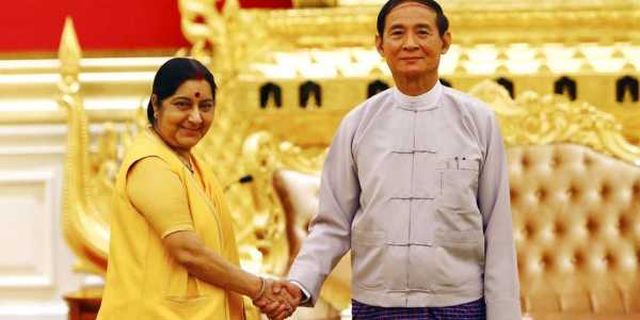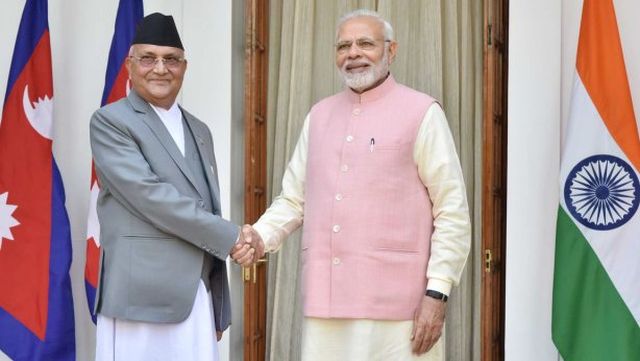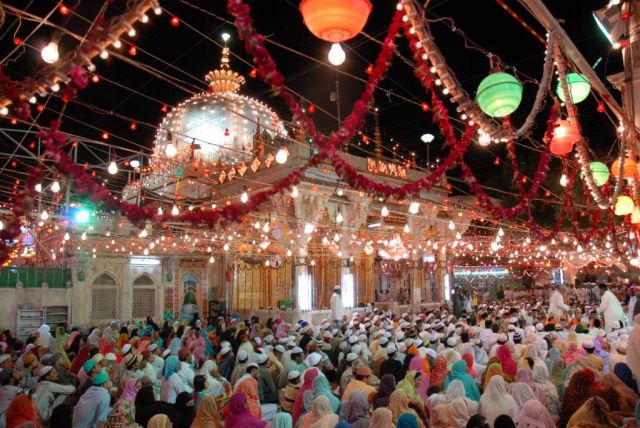
by Editor | May 25, 2021 | Business Summit, Economy, Events, News, Politics, Social Round-up
 New Delhi : As India and Bhutan mark 50 years of diplomatic ties this year, the two sides reaffirmed their commitment to cooperation in the hydropower sector during a meeting between Prime Minster Narendra Modi and his Bhutanese counterpart Tshering Tobgay here on Friday.
New Delhi : As India and Bhutan mark 50 years of diplomatic ties this year, the two sides reaffirmed their commitment to cooperation in the hydropower sector during a meeting between Prime Minster Narendra Modi and his Bhutanese counterpart Tshering Tobgay here on Friday.
“The two Prime Ministers reviewed the bilateral economic and hydro-power co-operation, including the progress in implementation of the on-going GoI-assisted-hydro-electric projects in Bhutan.” the External Affairs Ministry said in a statement.
“They agreed that the robust partnership in the hydropower sector was mutually beneficial,” it stated.
“They reaffirmed their commitment to further strengthen collaboration in the hydro-power sector in the spirit of close friendship and co-operation that characterize relations between India and Bhutan.”
India is a leading development aid partner for the Himalayan kingdom. There are a number of institutional mechanisms between India and Bhutan in areas like security, border management, trade, economy, hydroelectricity, development cooperation and water resources.
New Delhi has set up three hydroelectric projects in Bhutan with a total capacity of 1,416 MW, which are operational. About three fourth of the power generated is exported to India and the rest is used for domestic consumption.
India is also Bhutan’s largest trading partner.
In 2016, the bilateral trade stood at Rs 8,723 crore, with imports pegged at Rs 5,528.5 crore (82 per cent of Bhutan’s total imports) and exports at Rs 3,205.2 crore, including electricity (90 per cent of Bhutan’s total exports).
President Ram Nath Kovind said on Friday that India and Bhutan share an exemplary bilateral partnership and the relations between the two countries were unique.
Welcoming visiting Tobgay at Rashtrapati Bhavan, Kovind said the historical and cultural linkages between the two countries “make us natural friends”.
“India and Bhutan share an exemplary bilateral partnership. Our relations are unique and special,” he said.
—IANS

by Editor | May 25, 2021 | Corporate, Corporate Governance, News, Politics

Myanmar’s President Win Myint, right, shakes with visiting Indian External Affairs Minister Sushma Swaraj during their meeting at the President House in Naypyitaw, Myanmar.
New Delhi : India and Myanmar discussed a range of bilateral issues and signed seven agreements during External Affairs Minister Sushma Swaraj’s two-day visit to the country that concluded on Friday.
During the visit, Sushma Swaraj called on Myanmar President U Win Myint, State Counsellor and Minister for Foreign Affairs Aung San Suu Kyi and Commander-in-Chief of the Myanmar Defence Forces Senior General Min Aung Hlaing.
According to a statement issued by the External Affairs Ministry here, during the bilateral meetings, boundary and border related issues, peace and security matters, developments in the Rakhine State, including return of displaced Rohingya persons, India’s development assistance to Myanmar, ongoing projects, and other issues of mutual interest were discussed.
The seven agreements signed included one on land border crossing, memorandums of understanding (MoU) on restoration and preservation of earthquake-damaged Pagodas in Bagan, assistance to the Joint Ceasefire Monitoring Committee, training of Myanmar foreign service officers, setting up an Industrial Training Centre (ITC) at Monywa, and ITC at Thaton and exchange of letters on extending a maintenance contract for ITC Myingyan.
According to the ministry statement, the agreement on land border crossing “is a landmark in bilateral relations between the two countries as it will enable people from both countries to cross the land border with passport and visa, including for accessing health and education services, pilgrimage and tourism”.
“The MoU on restoration of pagodas at Bagan underlines the enduring cultural and historical links between the two countries,” it stated.
“The other MoUs on technical assistance and capacity building reflect India’s continuing support to Myanmar in accordance with this country’s own development plans and priorities.”
India is a key development aid partner for Myanmar and is implementing a number of infrastructure projects in that country.
These include the a transport project connecting Mizoram with Sittwe port in Myanmar, the Trilateral Highway connecting India with Myanmar and Thailand and the Rhi-Tiddim road.
According to the statement, Sushma Swaraj also reiterated India’s readiness and commitment to helping the Myanmar government in addressing issues related to Rakhine State in the wake of the Rohingya reugee crisis.
She welcomed the Myanmatr government’s “continued commitment to implementing the Rakhine Advisory Commission’s recommendations and noted that, under the aegis of the bilateral Rakhine State Development Programme, India was already in the implementation stages of various projects that would respond to the needs of different sections of the Rakhine State population”.
“The first major project is the construction of prefabricated housing in Rakhine State to meet the needs of displaced persons,” it stated.
“The Minister also underlined the need for safe, speedy and sustainable return of displaced persons to Rakhine State.”
Sushma Swaraj’s visit is part of the ongoing high-level interaction between India and Myanmar after that country got a democratic government in 2016 and can also be seen in the context of India’s increasing engagements with southeast Asia under New Delhi’s Act East Policy.
—IANS

by Editor | May 25, 2021 | Business, Corporate, Corporate Governance, Economy, Emerging Businesses, News, Politics
 New Delhi : After months of stress in ties, India and Nepal on Saturday agreed to crank-up cooperation in connectivity, trade, agriculture and border security as Prime Minister Narendra Modi gave an assurance that New Delhi remains committed to strengthening the partnership as per Nepal’s priorities.
New Delhi : After months of stress in ties, India and Nepal on Saturday agreed to crank-up cooperation in connectivity, trade, agriculture and border security as Prime Minister Narendra Modi gave an assurance that New Delhi remains committed to strengthening the partnership as per Nepal’s priorities.
Seeking to readjust the ties, Nepal Prime Minister K.P. Sharma Oli, on a three-day visit to India, held wide-ranging talks with Modi, who also assured the visiting leader that India would always back Nepal in its quest for development.
A joint statement issued after the talks said Prime Minister Oli stated that his government attaches high importance to further strengthening friendly relations with India. He expressed the desire of the Government of Nepal to develop bilateral relations in a way so as to benefit from India’s progress and prosperity for economic transformation and development.
“Prime Minister Modi assured Prime Minister Oli that India remains committed to strengthening its partnership with Nepal as per the priorities of the Government of Nepal,” the statement said.
Oli, who has developed closer ties with China with a known pro-Beijing stance, said he has come to India “with a mission” to take bilateral ties based on “principles of equality and justice” to newer heights but “commensurate with the realities of the 21st Century”.
In a joint address to the media with Oli, Modi hailed the Nepal Prime Minister’s “vision for a prosperous Nepal” that is in sync with his vision of “sabka sath, sabka vikas” (development for all).
“India stands ready to expand cooperation with Nepal as per Nepal’s priorities. We believe that enhanced connectivity between our countries will boost our economic growth and benefit our citizens.”
Modi hailed successful conduct of polls in Nepal and congratulated both the people of Nepal and the government for entering into “a new era of political history”.
He said the two countries agreed to put on faster tracks all connectivity projects, announcing that a new railway line will be built “with India’s financial support” to connect the border city of Raxaul in India to Kathmandu in Nepal.
The objective, according to a joint statement, is to expand “connectivity” between the two neighbours and “enhance people-to-people linkages and promote economic growth and development”.
Prime Ministers Modi and Oli also recognised the untapped potential of inland waterways between the countries that can contribute in an overall economic development of the Himalayan region.
Towards that, the statement said, they took a “landmark decision” to develop the inland waterways for the movement of cargo, within the framework of trade and transit arrangements, providing additional access to sea for Nepal.
This will enable cost effective and efficient movement of cargo and greatly impact the growth of business and economy of Nepal.
The connectivity proposals are significant and come nearly two years after China in March 2016 agreed to construct a strategic railway link with Nepal through Tibet to reduce the Kathmandu’s total dependence on India.
That year China also signed a transit trade treaty with Nepal that completely depends on Indian sea ports for third-country trade. Apart from this, China is also building three highways connecting Nepal and these roads are expected to be ready by 2020.
The Nepal-China agreements came at a time when Kathmandu-New Delhi ties started soaring after a border blockade in 2015-16. Many in Kathmandu blamed India for the 135-day blockade from September, 2015 to February, 2016 that crippled Nepal’s economy.
China expanding its strategic base in Nepal sparked concerns in India that it was losing its foothold in its immediate backyard despite its “neighbourhood first” policy.
But Oli’s April 6-8 visit indicated a new India-Nepal bonhomie during which he and Modi announced enhanced security ties, particularly on borders to curb curb misuse of open boundaries between the two countries.
“We have strong relations when it comes to the aspect of security and are committed towards stopping misuse of our open borders,” said Modi, with Oli by his side.
Oli said his government accorded a priority to friends like India that has helped his landlocked nation in fighting poverty.
“Friendship is very important. We have developed our friendship according to time with a purpose to eradicate poverty, improve life standards. Our friendship is historical, renewed, developed and is very fruitful. Looking ahead and not looking back”
He said his country always accorded “great importance” to its ties with India as the two neighbours have many “things to offer each other”.
“Inter-dependence takes many forms between our countries. Relations between neighbours are different than others. They rest on principles of equality and justice.
“I have come to India with a mission to enhance our relations to newer heights commensurate with the realities of the 21st Century. We want to create a model relationship. A relationship that is cherished forever,” he said, renewing his invitation to Modi to pay a visit to Nepal at the earliest.
Boosting their ties further, India also agreed to conduct a pilot project on organic farming and soil health monitoring in Nepal to help the natural resource-rich neighbour in developing agriculture and allied sectors.
Oli and his wife Radika Shakya, who arrived here on Friday, earlier paid tributes to Mahatma Gandhi at Rajghat, before driving to the President’s house for a ceremonial welcome.
Viewed as an important visit, Oli has flew in a 54-member high-level delegation to India, seeking more investment from India’s public as well as private sector.
This is Oli’s first foriegn trip after returning to power for the second term in February.
—IANS

by Editor | May 25, 2021 | News, Politics
 Islamabad : Islamabad said on Monday that New Delhi denied visa to more than 500 pilgrims who were to join the annual Urs celebrations at Ajmer in India this month.
Islamabad : Islamabad said on Monday that New Delhi denied visa to more than 500 pilgrims who were to join the annual Urs celebrations at Ajmer in India this month.
“Pakistan notes with deep disappointment the non-issuance of visas by India for the visit of the 503 Pakistani (pilgrims) to participate in the Urs of Hazrat Khawaja Moinuddin Chishti at Ajmer Sharif on March 19-29,” the Foreign Ministry said in a statement.
The Pakistani pilgrims have been deprived of the opportunity to participate in the gathering, which is of special significance to them, the statement said.
Earlier, 192 Pakistani pilgrims could not take part in the annual gathering of another Sufi saint, Hazrat Khawaja Nizamuddin Aulia, in Delhi in January due to the non-issuance of visas by India, according to the foreign ministry.
—IANS

by Editor | May 25, 2021 | Corporate, Corporate Governance, Corporate Reports, News, Politics
 By Arul Louis,
By Arul Louis,
United Nations : As New Delhi diversifies its arms purchases, the US is rapidly increasing its arms sales to India, emerging over the last five years as its second biggest supplier by providing 15 per cent of its weapons imports, a study by Sipri said.
Washington increased its sales by more than five times compared to the previous five years, the authoritative Stockholm International Peace Research Institute said in its report released this week.
Israel has moved up to the third spot accounting for 11 per cent of India’s imports during the 2013-17 calendar years, Sipri added.
Although Russia remained by far India’s biggest arms seller, it share of total imports has fallen.
Russia had a 62 per cent share of India’s arms imports during the past five years, down from 79 per cent in 2008-12, according to the report that tracks the global arms trade.
Overall, India is the world’s biggest importer of major arms accounting for 12 per cent of the total global imports during the last five years and it increased purchases abroad by 24 per cent compared to the previous five-year period, Sipri said.
“The tensions between India, on the one side, and Pakistan and China, on the other, are fuelling India’s growing demand for major weapons, which it remains unable to produce itself, Sipri Senior Researcher Siemon Wezeman wrote.
“China, by contrast, is becoming increasingly capable of producing its own weapons and continues to strengthen its relations with Pakistan, Bangladesh and Myanmar through arms supplies,” he wrote.
In contrast to India, Pakistan’s arms imports declined significantly during the last five years, when imports from the US dropped dramatically compared to the previous five years while supplies from China increased.
“Despite its continuing tensions with India and ongoing internal conflicts, Pakistan’s arms imports decreased by 36 per cent between 2008-12 and 2013-17,” the report said.
“Pakistan accounted for 2.8 per cent of global arms imports in 2013-17.”
Pakistan’s arms imports from the US dropped by 76 per cent in the latest five-year period compared with the previous one, the study said.
China was Pakistan’s main source of arms in 2013-17, and there was a large increase in Chinese arms exports to Bangladesh in that period, Sipri said.
According to supplementary arms import data for India provided to IANS by Sipri, the share of India’s imports from the US increased from 2.7 per cent of its total during 2008-12 to 15 per cent in the latest five-year period as it overtook Uzbekistan, Britain and Israel.
Uzbekistan, which was India’s second biggest import source accounting for 4.3 of its purchases abroad during 2008-12 did not sell any after 2011, according to the data.
Weapons imports from Britain fell to 3.2 per cent of the total during the last five years, while it was 5.2 per cent in 2008-12, a drop of 23 per cent during that period that moved it down from the third spot to the fifth.
France has moved up to the fourth spot accounting for 4.6 per cent of India’s imports during the last five years, an increase of 572 per cent compared to just 0.8 per cent.
Sipri does not assign monetary values for the arms trade and uses its own system called Trend-Indicator Value (TVI) because “data available from public sources will give sometimes monetary values, but also often such values are not available, not detailed, not clear or not comparable (between countries who report on different ‘weapons’ or as the coverage changes over time) enough to be useful,” Wezeman explained to IANS.
Under this way calculating, India’s total TVI rose from 14,608 during 2008-12 to 18,048 for 2013-17.
According to this valuation system, India’s arms purchases have come down during the last full three years of Bharatiya Janata Party government compared to the last three full years of the Congress-led United Progressive Alliance rule.
During 2011-13, India’s imports were valued at 13,319 TVI by Sipri, but only 9,499 TVI in 2015-17. When both parties held power at different times during 2014, the imports were 3,227 TVI.
(Arul Louis can be reached at arul.l@ians.in)
—IANS

 New Delhi : As India and Bhutan mark 50 years of diplomatic ties this year, the two sides reaffirmed their commitment to cooperation in the hydropower sector during a meeting between Prime Minster Narendra Modi and his Bhutanese counterpart Tshering Tobgay here on Friday.
New Delhi : As India and Bhutan mark 50 years of diplomatic ties this year, the two sides reaffirmed their commitment to cooperation in the hydropower sector during a meeting between Prime Minster Narendra Modi and his Bhutanese counterpart Tshering Tobgay here on Friday.



